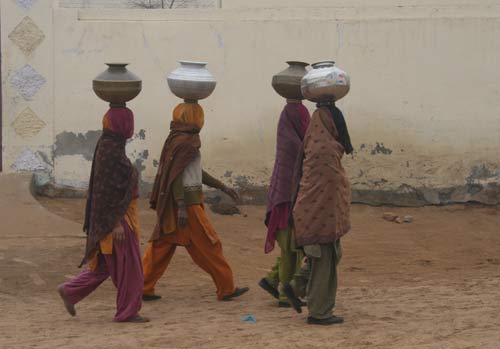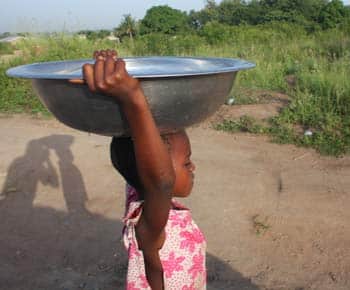by Elayne Clift
Her day begins before dawn. She walks over four miles on uneven paths to reach a hand-dug pit from which she fetches the day’s water supply for her family. The water is polluted by flies, feces and feeding animals. In the dry season the walk is often treacherous as steep-sided mud walls collapse, injuring the women and girls who come, sometimes twice a day, for precious water. By the time she returns home carrying a water jug on her head that weighs as much as a baby giraffe, she is exhausted. Still, at night she must walk to the latrine, often in the dark, putting herself at risk of sexual assault.
This is daily life for many women, as it was for Nakwetikya from Tanzania, until a British-based organization, Water Aid installed a well in her village. “The situation here was bleak,” she says. “There was no water and we had to dig pits to find some. My legs used to shake with fear before climbing down those holes. But there was no choice. If I didn’t get water my family couldn’t eat, wash, or even have a drink.”
Lack of water and sanitation has an enormous impact on the lives of millions of women around the world. In a single day, for example, more than 200 million collective hours of women’s time is consumed by collecting water for domestic use. And more than 600 million women live without safe drinking water and basic hygiene facilities.
A Deluge of Gender Impacts
The availability of water affects women’s health in a variety of ways. They suffer back injuries, curved spines and pelvic deformities from carrying such huge water supplies on their heads. Ironically, they are often dehydrated. They are subject to bouts of malaria, diarrheal disease and parasites. And almost one-tenth of the global disease burden, which women primarily bear as caregivers, could be prevented by improving water supply, sanitation, hygiene and management of water resources, according to Water Aid.
Such improvements call for women to be at the decision-making table because they understand what is needed to make water safe and available. Projects designed and run with the full participation of women have proven to be more sustainable and effective. “As the main users of future water points women are best placed to choose the ideal location of a water source, and they have a great deal of crucial knowledge in the planning stages, such as where the nearest, cleanest sources of water are and when they dry out,” says Water Aid. Equally, the group says, “women must understand the benefits of good hygiene such as covering stored water, hand washing before eating or after defecating, and using dish racks to keep utensils off the floor.”
| When it comes to water, we are all equal. |
Women’s economic and social status is also affected by access to clean water in ways that are vitally important from a gender perspective. Young girls who no longer have to haul water can go to school and if those schools have proper toilets menstruating young women can stay in school. Women who are not burdened by family illness can work in the marketplace or in the field, adding to family income. Over time, they can assume greater responsibility in the community, as Nakwetikya testified in a set of case studies published on Water Aid’s website. “Since having this new water source,” she says, “life has changed in amazing ways. My status as a woman has finally been recognized (since serving on the water committee). Before, men saw women as bats flapping around. No one would allow us to speak or listen to what we say. When I stand up now I am not an animal. I am someone with a valid opinion.”
The global challenges around water are serious and growing. The United Nations estimates that by 2025 a total of 48 countries with a combined population of 2.8 billion people will face freshwater “stress” or “scarcity.” Right now, less than one percent of the world’s fresh water is readily accessible for direct human use.
Cascading Harms
Growing populations and unsustainable lifestyles are adding to worries about water shortages. Women remain most vulnerable because they often work in informal markets and don’t have the financial resources to buy water in competitive markets, even as these competitive markets are, in fact, worsening water scarcity. There are also concerns about the privatization of water, which drives prices up and affects distribution. As managers of households women are the first to realize the effects of water competition. That’s why it is so important that women’s voices be heard at all levels of governance, ensuring equitable access to water in a water-scarce world.
Climate change, defined by the Environmental Protection Agency (EPA) as any significant change in temperature, precipitation or wind lasting for decades or longer, also brings challenges. Droughts and floods become more frequent and extreme, reducing not only water access, but its quality. According to the EPA, “Throughout the world, the prevalence of some diseases and other threats to human health depend largely on local climate. Extreme temperatures can lead directly to loss of life, while climate-related disturbances in ecological systems…can indirectly impact the incidence of serious infectious diseases.”
In addition, environmental educators and advocates around the world underscore that as industrialized countries continue to pollute rivers and other sources of water with pesticides and toxic waste, the world’s poorest people — always women — bear the brunt of those actions as they try to provide for and take care of their families.
In its 2010 “Women, Water, Workers and Health” campaign, Public Services International (PSI), a global federation of public sector trade unions, called for access to clean, safe water as a means of reducing poverty, promoting gender equality and ensuring good health for all. Getting more women to become actively engaged in trade unions is one of its goals because “trade union members are often front-line experts with hands-on knowledge of how to improve management and delivery of quality water and health services. They know which systems can be improved and how resources can be used more effectively.”
Along with organizations such as Women’s Environment & Development Organization (WEDO) and the Feminist Majority Foundation, PSI points out that when it comes to water, we are all equal. “We all need water to live. There are no exceptions.” Recognizing the interdependency between the right to water, the right to health and other social, economic and cultural rights, it cites two of the eight Millennium Development Goals (MDGs) developed by the United Nations. MDG 3 seeks to empower women, and MDG 7 is geared to ensuring water supply and sanitation. Addressing these cross-cutting issues together, experts say, will be much more successful in achieving a healthier, more equitable world for all.
Women like Nakwetikya couldn’t agree more. “When I heard that we were going to get clean water I laughed. I could only compare it to someone who is in prison for a long time. When they are set free, it’s the most fantastic experience!”
Elayne Clift writes about women, health, development and social issues from Saxtons River, Vt. www.elayne.clift.com.
Also see: Swamped: Trying to Save Fragile Bodies by Molly M. Ginty in this edition of On The Issues Magazine
Also see: A Tale of Two Nursing Mothers by Chanda Chevannes in this edition of On The Issues Magazine
Visit The Café of On The Issues Magazine for new stories and updates.


